There was always, in the history of aviation, an interest in human-powered flight because Leonardo da Vinci drew a man flying a machine and because, when you observe a bird, you wonder if man can emulate it.
Paul MacCready was born to well-to-do parents in New Haven, Connecticut. He experienced difficulties in school, of a kind that might now be diagnosed as dyslexia or another learning disability, but he enjoyed math and physics and gave extra attention to the subjects he found more difficult. From an early age, he was an enthusiastic builder of model airplanes and gliders. Throughout his teens, he won competitions and set records with flying models of his own design. He began flying in his teens and received formal flight training in the U.S. Navy during World War II.
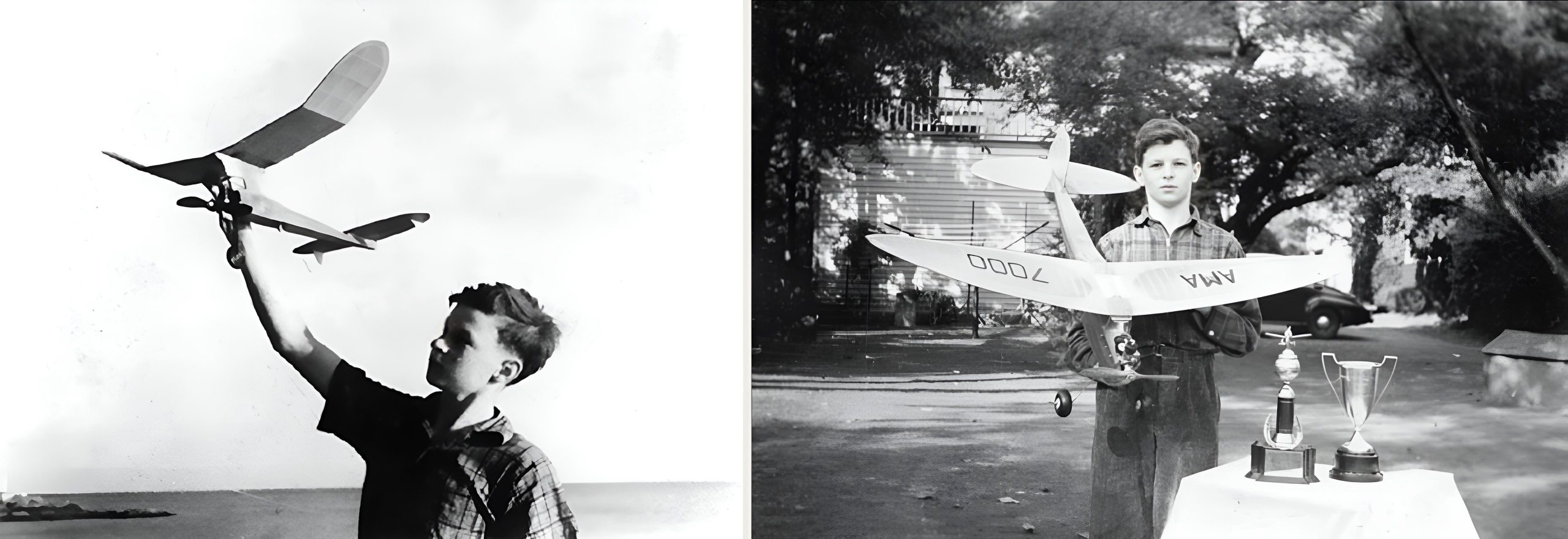
After the war, he earned a physics degree at Yale University and a doctorate in aeronautical engineering from California Institute of Technology in Pasadena. At the same time, he took up soaring — that is, flying sailplanes or gliders, as they are often called. He won U.S. soaring championships in 1948, 1949, and 1953, and represented the U.S. in international competition on four occasions. In 1956, he became the first American to win the world championship. He was the inventor of the MacCready Speed Ring, used by glider pilots the world over to select optimum flight speed.

MacCready founded his first company, Meteorology Research, Inc., in 1951, to pursue weather modification and atmospheric research. In 1971, he founded AeroVironment, Inc., in Monrovia, California. The company advises other businesses on environmental issues and wind power. It was also a pioneer of remote-controlled electric planes and unmanned aircraft systems. First marketed as toys, AeroVironment’s unmanned aircraft systems soon became reconnaissance tools for the Department of Defense, early examples of what is known today as drone technology.

A debt MacCready incurred helping a relative in business difficulties inspired him to pursue the prize offered by British millionaire Henry Kremer and the Royal Aeronautical Society to the designer who could create a human-powered flying machine. For 18 years, the prize had gone unclaimed. MacCready’s Gossamer Condor made history in 1977, when it flew a figure-eight course over a distance of 1.15 miles and became the first human-powered vehicle to achieve sustained, maneuverable flight.
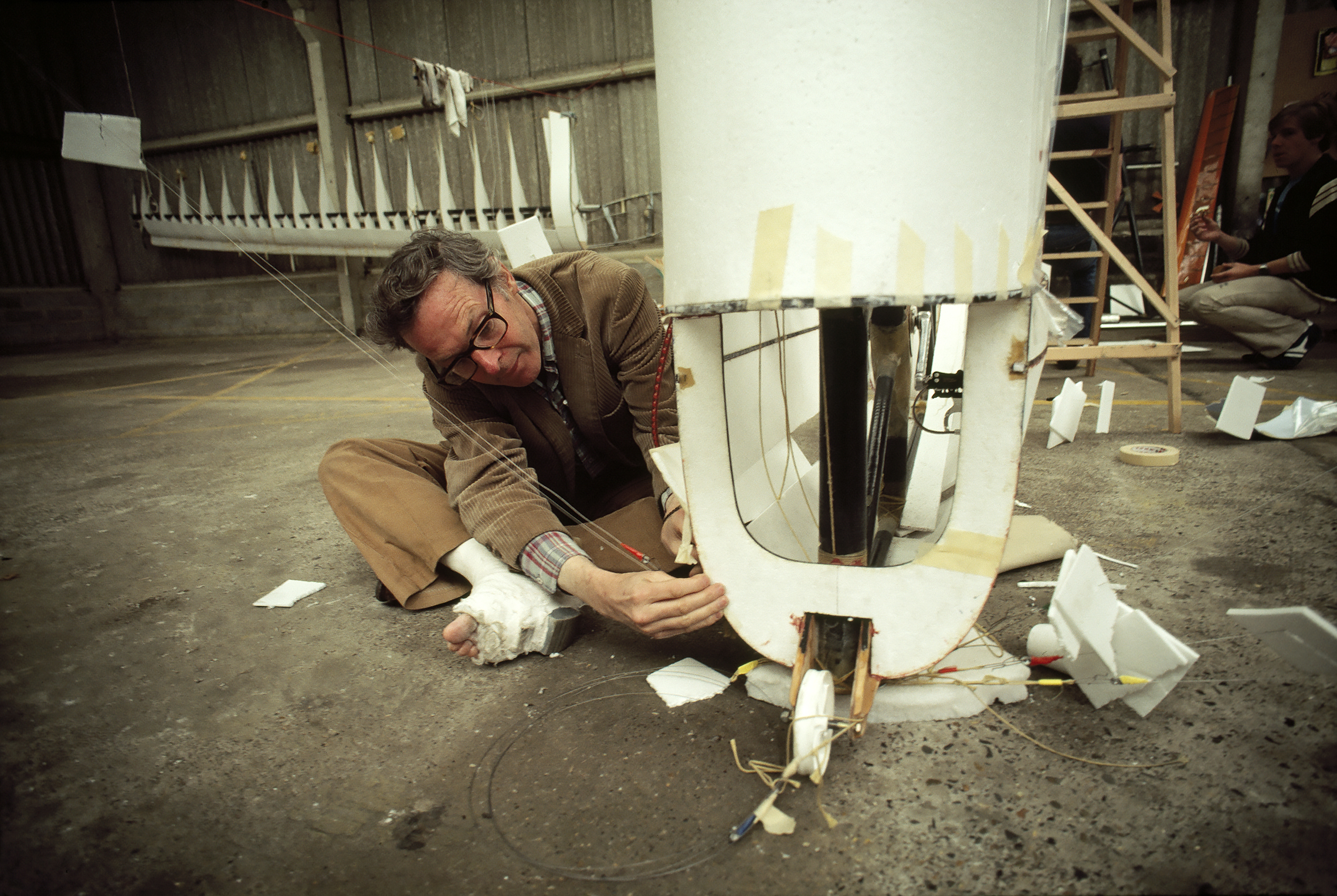
Kremer offered another prize of 100,000 British pounds for the first human-powered crossing of the English Channel. In 1979, the Condor’s successor, the Gossamer Albatross, flew across the Channel and won the second Kremer Prize. MacCready’s Bionic Bat won a third Kremer Prize for human-powered airspeed. The bat (short for battery) uses human power not only to power the aircraft directly but to continually recharge a battery, which stores power for continued flight.
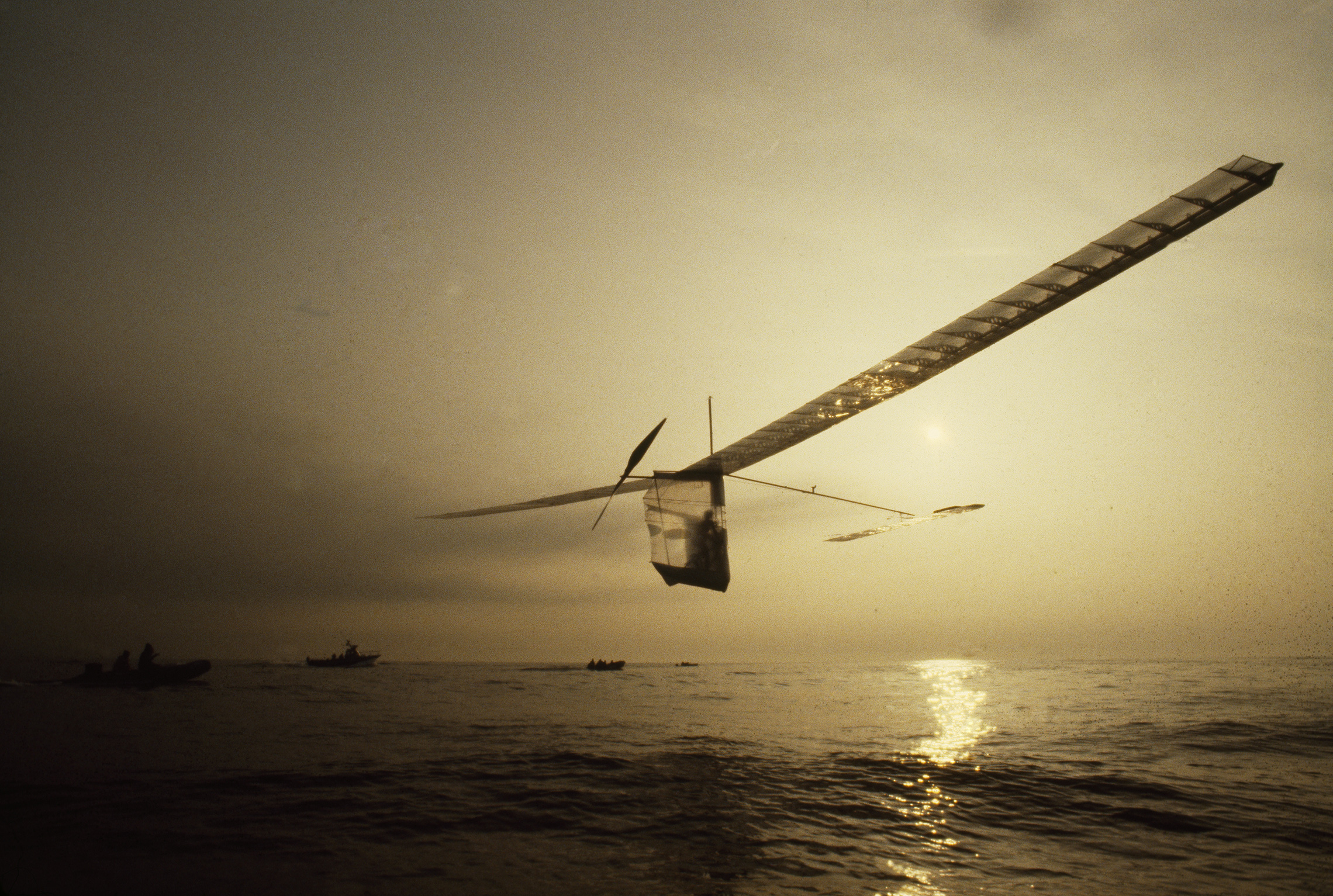
In addition to these, MacCready created the Gossamer Penguin, the world’s first successful totally solar-powered airplane, and the Solar Challenger. Unlike MacCready’s previous creations, the Solar Challenger was not designed to win a competition, but to awaken the public to the possibilities of solar energy. In 1981, the Challenger flew from Paris, France to Canterbury, England, a distance of 163 miles, rising to an altitude of 11,000 feet.
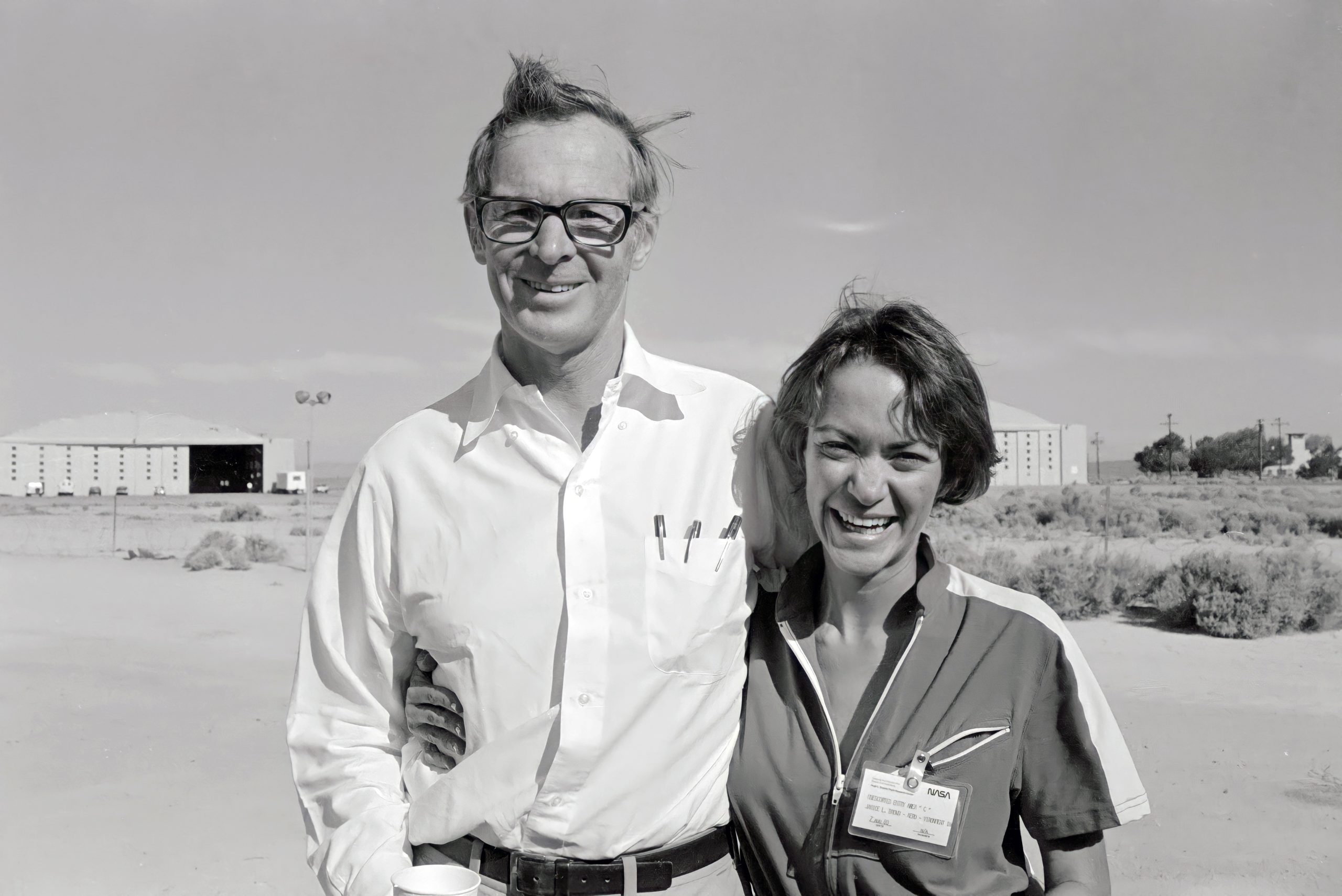
In 1985, the Smithsonian Institution commissioned MacCready to build a life-size flying replica of the pterodactyl, a prehistoric flying reptile with a 36-foot wingspan. This remote-controlled flying model can be seen in the IMAX film On the Wing.
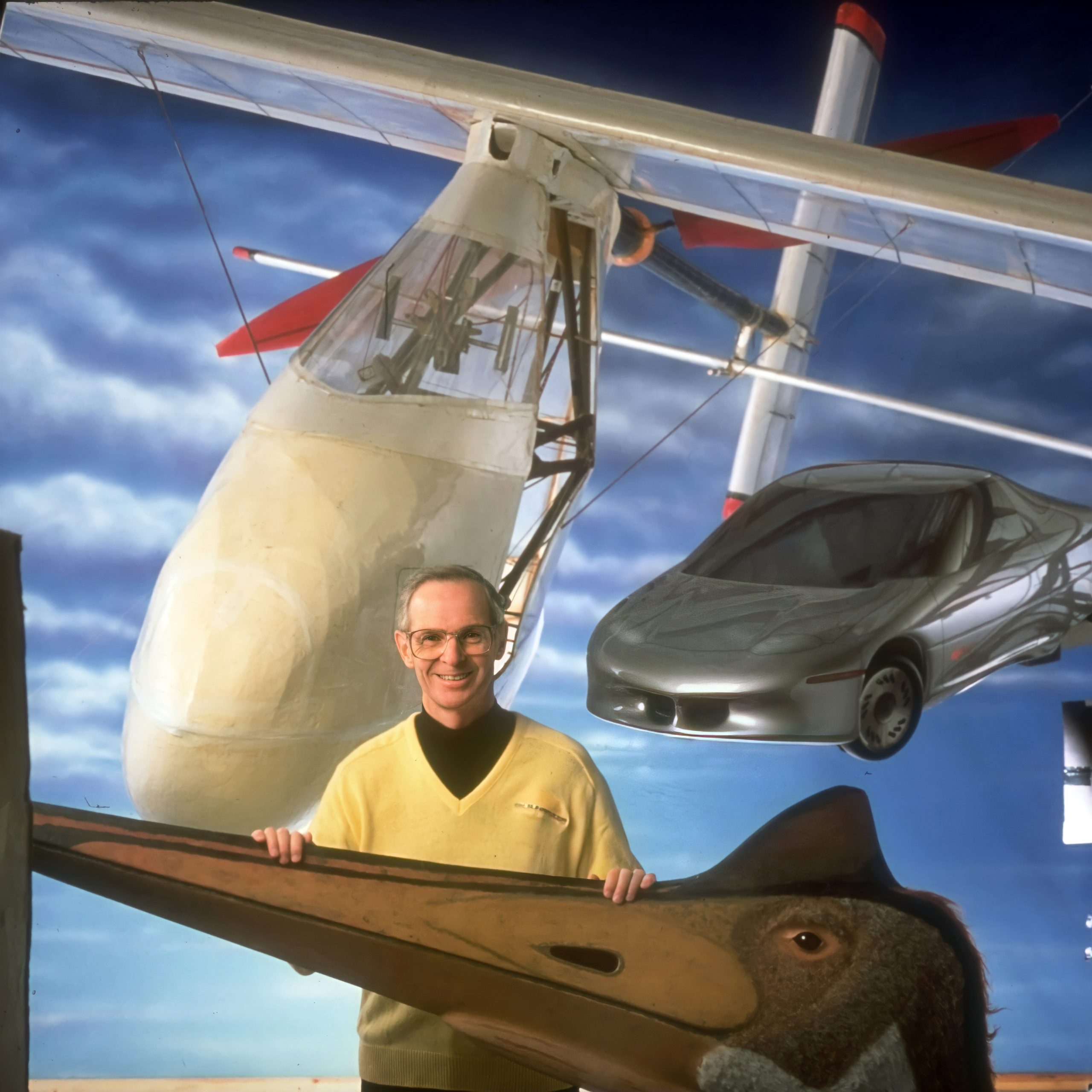
MacCready did not limit himself to the development of unique aircraft. His interest in environmentally sound technology led him to develop innovative surface vehicles as well. In 1987, he built the solar-powered Sunraycer, to compete in a race across Australia. In 1990, a collaboration with General Motors resulted in the Impact, an electric car that could accelerate from zero to 60 mph in eight seconds.
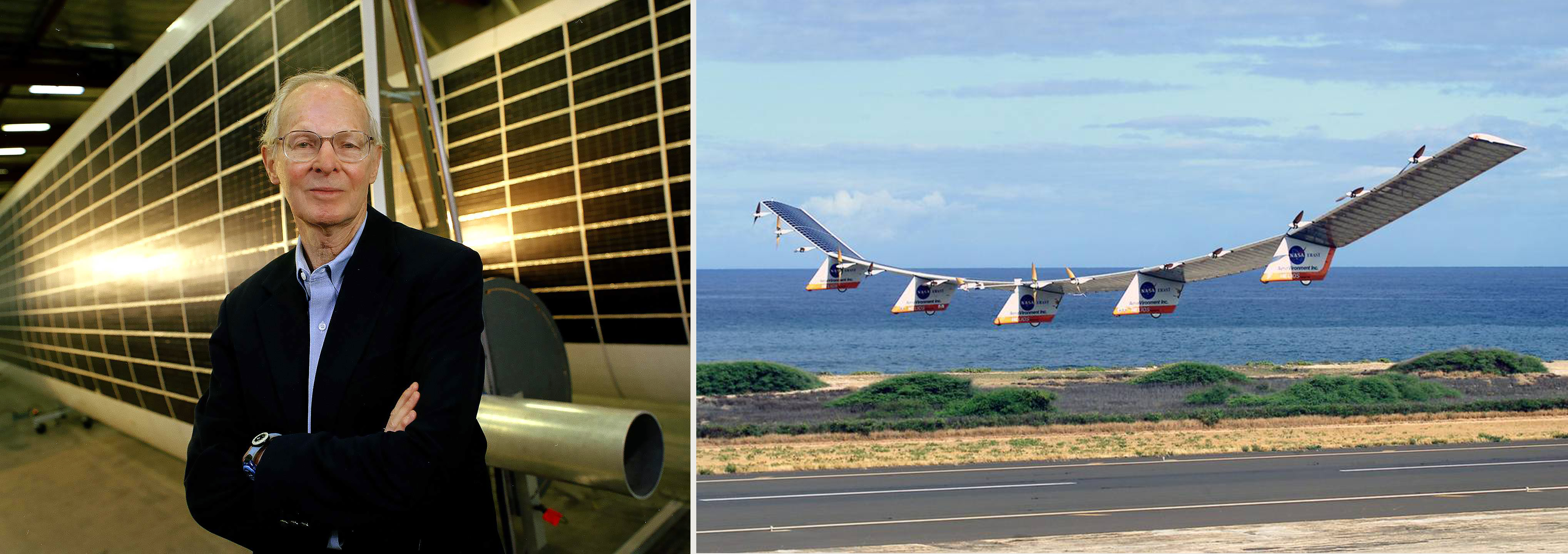
Paul MacCready’s contributions to flight technology were recognized formally in 1991 when he was inducted into the Aviation Hall of Fame, but MacCready and his collaborators at AeroVironment had not yet exhausted their ingenuity. In 1995, their remote-controlled, solar-powered Pathfinder reached an altitude of 50,500 feet. Since Paul MacCready’s passing in 2007, the enterprise he founded has continued to thrive. Today, AeroVironment is the largest supplier of unmanned aircraft systems to the Pentagon and to America’s allies; they are also used in law enforcement, border control, and emergency response. Whatever shape the air and surface vehicles of the future may take, it is certain they will be marked by the singular genius of Paul MacCready.
June 25, 1979: Paul MacCready’s Gossamer Albatross flies across the English Channel.

For centuries humans dreamed of flying on their own power. After the achievement of heavier-than-air flight at the beginning of the 20th century, most inventors and dreamers abandoned the idea of human-powered flight. Many dismissed it as impossible. One who did not was Paul MacCready. After half a lifetime of experimentation with gliders, MacCready answered a challenge issued by the Kremer Prize committee to produce a human-powered flying machine.
The human-powered Gossamer Condor was only the most famous of Paul MacCready’s innovative air and land vehicles. His Gossamer Penguin and Solar Challenger were the first successful solar-powered aircraft. MacCready also drew on the energy of the sun to power a high-performance automobile, the Sunraycer.
Paul MacCready overcame a childhood learning disability to earn a doctorate in aeronautical engineering and become a champion glider pilot. MacCready joined his lifelong interest in aviation with a mature passion for developing environmentally sound transportation technology. In addition to his experiments with solar power, MacCready’s firm AeroVironment, Inc. developed efficient battery-powered vehicles, such as the Impact sports car for General Motors. AeroVironment continues the legacy of Paul MacCready as a world leader in unmanned aircraft systems.
How did you come to address the challenge of human-powered flight? Where did this interest come from?
Paul MacCready: There was always, in the history of aviation, an interest in human-powered flight because Leonardo da Vinci drew a man flying a machine and because, when you observe a bird, you wonder if man can emulate it. When the Wright brothers began engine-powered flight, people realized that human-powered flight really was pretty impractical. A human puts out about a third of a horsepower, but engines put out ten horsepower, 100 horsepower, 1,000 horsepower. Eventually, airplanes achieved all sorts of great goals with those engines, so human-powered flight was just forgotten. But as an old goal, it still lingered in people’s minds. There were some tiny prizes put up for it in the ‘30s which weren’t won. And then…
A group in England called the Manpowered Aircraft Group assembled itself and began working on it on a very low level, hobby basis. One of the stalwarts in that group was the head of one of the companies that the British industrialist Henry Kremer had. He would ask this person how that program was coming. One time after one of the divisions of his empire had been sold and Kremer was having a three-martini lunch, he asked how it was going. It wasn’t going very well. “Well, how can you get it moving?” “Well, maybe a prize would be a good idea.” And Kremer said, “Well, I’ll put up a prize.” It was just done like that. Kremer was pretty far-sighted and was an enthusiast for physical conditioning, but I don’t think it had huge deliberation in it. It really was a very important event to take place, to put up a prize which eventually became a very significant prize.
All of us have known power — big power, available cheaply — our whole lives. You always have a 100-horsepower or 200-horsepower car and all the heat you need in your house, and so on. It’s hard to realize that just 200 years ago, all our ancestors were getting by for transportation on biological power — walk, run, whatever, use a horse. Then occasionally, you’d use windmills for some things, and water power, and there’d be sailboats. Basically, we got by on those puny powers, and now we can’t even conceive of how we would do it. So here is this Britisher who, in effect, said, “Go back to the power that we were using — but use modern technology — and fly. Fly on a third of a horsepower.” That was an amazing challenge of great value — to think of biology and nature at the same time that we are thinking of technology, and also to think about how little energy and materials we could get by with. This challenge was not just another ordinary one; it had great value. We can see that challenge produced our — and the significant prize — produced our Gossamer Condor, without which there would not have been the Gossamer Albatross, without which there would not have been the Solar Challenger or the Pterodactyl. Without all of these, there wouldn’t have been the Sunraycer, the solar-powered car that won the race across Australia in ‘87. And without that, there would not have been the Impact battery-powered car that now is going into mass production. As you look back in roots, you realize that was a pretty important lunch that took place many, many decades ago.

How about you? What was it about this challenge of human-powered flight that fascinated you?
Paul MacCready: What was really fascinating about human-powered flight was there was a £50,000 prize for achieving it. That’s the sole reason that I got into it. A subsequent project of human-powered flight was the Gossamer Albatross flight across the Channel. That prize was £100,000. That was the glorious motive for doing that project. But afterwards, the programs were done for somewhat more altruistic reasons, and in a rather unplanned way, one thing led to another. We couldn’t have anticipated what happened. They all have tended to feature light weight, pushing the frontier, low power, electric power, solar power, and human power. There was a lot of random influence in the projects, but it all began because of prize money.
You had a particular reason you were interested in that prize money. What was it?
Paul MacCready: I had guaranteed a relative’s loan at a bank for roughly $100,000 for him to start a company, which didn’t succeed. He couldn’t pay the money back, and as guarantor of the note, I was obligated to pay the money back. Because of some peculiar circumstances, where I thought I had some liquid assets around, they had evaporated while all this was going on. So I was stuck with the debt, which was rather annoying. There wasn’t anything I could do about it. I didn’t have any special plans on what to do. I couldn’t figure out how to handle it. I was going on this vacation trip in the summer of 1976, having time to just daydream, let the mind dawdle around on what it wanted to think about — nibbling away on little old memories and new thoughts and making connections that I otherwise would not have made. I did recall, with no special emphasis, this £50,000 prize that Henry Kremer had put up 17 years earlier. And then, one day I happened to notice that at that time the pound was worth just two dollars. And suddenly, this great light bulb just glowed over my head — the prize was $100,000! My debt was $100,000! There just may be some interesting connection between these two. My interest in human-powered flight suddenly zoomed up to high level. I fussed away at it, and eventually it worked.
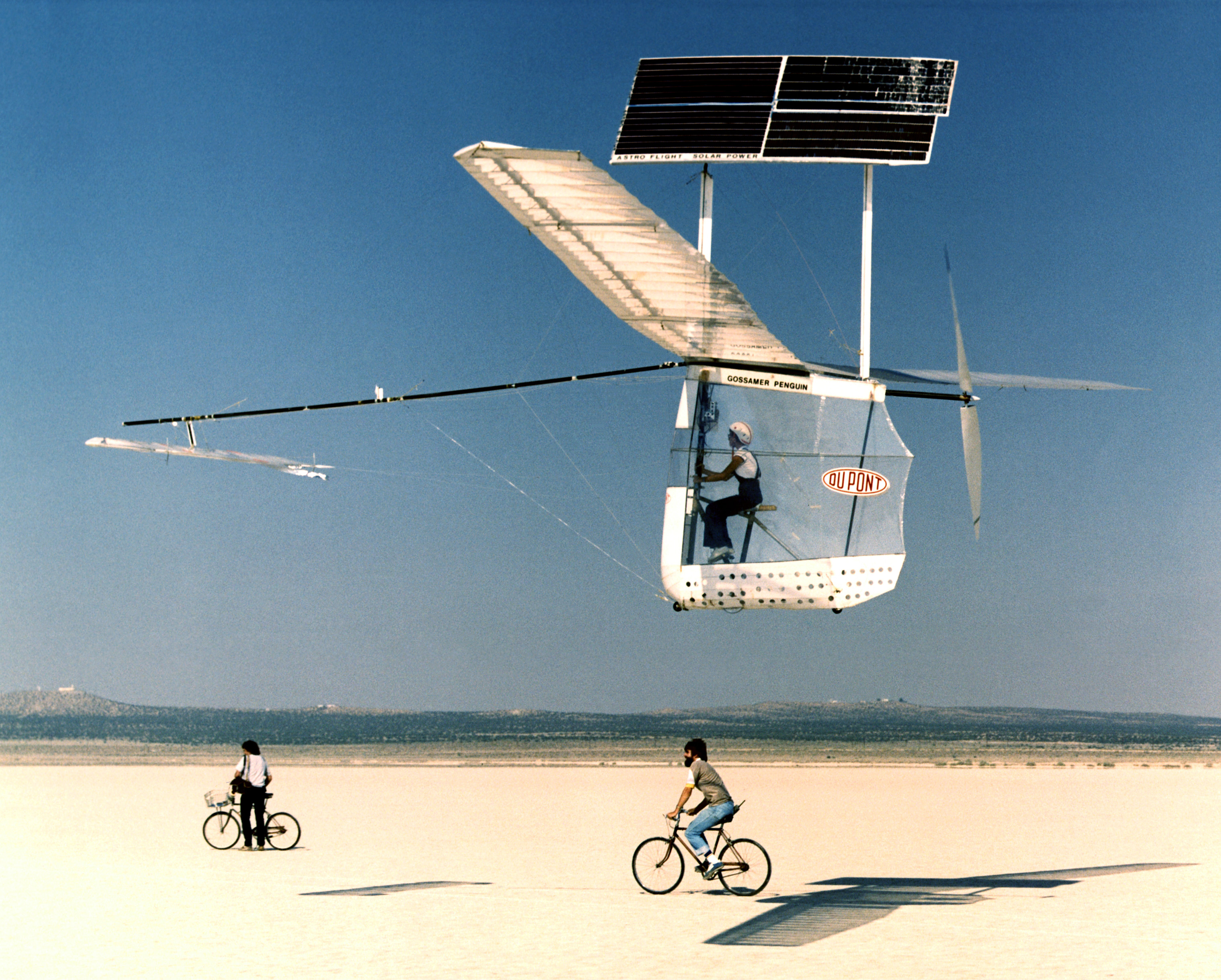
It’s fascinating to think how the challenge that Kremer thought about, and the prize money attached to meeting that challenge, and your financial need, coincided. What was the next step?
Paul MacCready: Well, first of all, I realize, looking back, that for me, right at that time, with my particular skills, strengths, and weaknesses — which all helped with it — it was almost as though the Kremer Prize was designed for me. At that stage, there wasn’t anybody in the world as well-situated to handle it — with knowledge of aerodynamics but no knowledge of structure, so I could more flexibly deal with new methods there. Living in Southern California, where all the aerospace technologies are around, if you need some tubing, you just go buy it. If you need it chemically-milled, you take it someplace else, they chemically mill it. You couldn’t do this in the middle of some other state in the United States or some other country — and where you can get a good airport and an empty hangar if you hunt around for it. And the weather is gentle. And so many things — it almost seemed like this was the perfect spot to win that prize.
Chances combined to create the interest in you, and in the perfect spot, to meet this challenge. What was the next step for you?
Paul MacCready: Every time I came up with an idea, it turned out it was just the same as the teams in England, rather elegant groups that made rather sophisticated aircraft that didn’t come close to winning the prize. Their lack of success demonstrated that those approaches really were not very good. Plus, I couldn’t aspire to make such complex, elegant aircraft as they had made.
In this case, what I was doing was just a fun little scientific hobby. I realized on a vacation trip that you could figure out the flight speed and the turning radius of birds flying around in circles — just soaring in circles like you see a hawk do or a turkey vulture — by noting the time to do a turn and estimating the bank angle at which the bird was operating. From those two numbers, you can immediately calculate the flight speed and turning radius, and you can do it with essentially no tools, just your wristwatch and estimating the bank angle. You have to write a formula and use a little calculator for it. So we were doing this on this vacation trip and comparing the black vulture with the turkey vulture, which flies slower, in smaller thermals, and can take off earlier in the day when the thermals are smaller.
We began to be more interested in how one bird compares with the other, and I found myself thinking about “How does this compare with a hang glider? Can it fly at the same turning radius? What about sailplanes? How much power does each take? What about the power per pound?” I was doing the scaling laws for all of these different flight devices, natural and artificial, in my mind. The scaling laws are pretty simple. While working on that, I thought back about human-powered flight and realized, why yes, there was a very simple, straightforward way of doing it, which is merely that you can take any airplane conceptually — keep the weight the same, but let the size just get bigger and bigger and bigger in all dimensions, and the power goes down. And conceptually, you can make it big enough so it can get by on the tiny power that a person puts out.

When you work out numbers, you realize if you take a hang glider, sort of a 30-foot span, and keep the weight the same — sort of 50 pounds, 70 pounds, something like that — and swell it up to a 90-foot span, and the chord, increase also, the power goes down to one-third of what it was, and that brings it down to about point-four horsepower, which a person — a good athlete — can put out for some number of minutes. You didn’t need an elegant sailplane-like aircraft. You could have an ugly, dirty-looking hang glider-type plane, quick to build, as long as you made it giant without the weight going up.
That was the basic idea. There is one other idea that was essential, which was how to make something that big without the weight going up. The gimmick was that you did not need a structural safety margin that you need in a regular hang glider, which is going to fly at high altitudes, so if it breaks, somebody is going to get hurt. This was only going to fly at ten-feet altitude at ten miles an hour. If it broke, who cared? Nobody would get hurt at all. You could have it just on the very edge of breaking — no safety margin at all. Instead of cables, you use thin piano wire as a structural element. And so, with that idea and the basic idea of “large and light,” the problem was solved. I knew there would be a bunch of grunt work, engineering, to actually win the prize, but the idea that assured that the prize could be won was then in possession.
It had to be large and light, larger and lighter than any plane had been made until then. It ended up 96-foot span and 50 pounds, occasionally up to 70 pounds, which is unprecedented in the way people have made airplanes.
Some airliners — I forget — the DC-9, 727, they are around that wingspan. But then the 747 would be sort of a 150-foot span. So it’s smaller than a jumbo jet, but it’s actually larger than some of the smaller transports that you see in the sky — but a lot lighter by a good bit and a lot slower. It doesn’t carry many people, and the people it carries have to work pretty hard.
When you started building the Gossamer Condor, did it turn out to be a bigger task than you anticipated?
Paul MacCready: Oh, yes. Every task I get involved in is always a lot bigger than I expect. I naively think we just do this and that and it will work. But it never happens. People who work with me sometimes double the time estimates, other times they increase them by a factor of ten; the latter are usually more correct. We were entering such a new realm of flight. We couldn’t predict what was going on. Looking back, we did it just right, as quickly as we could. After some early tests and models and a bunch of calculations, we built a first version without even putting a propeller on it, just to see if it would fly and about how much power it took to keep it up. Then we added a propeller and did a lot of tests. It was pretty crummy, very crude and not efficient, bad stability and control, and so on. But because we could rush it out and do tests with it, we began getting good insights about all its difficulties and then were able to do a lot of work to come up with the more elegant devices that followed.
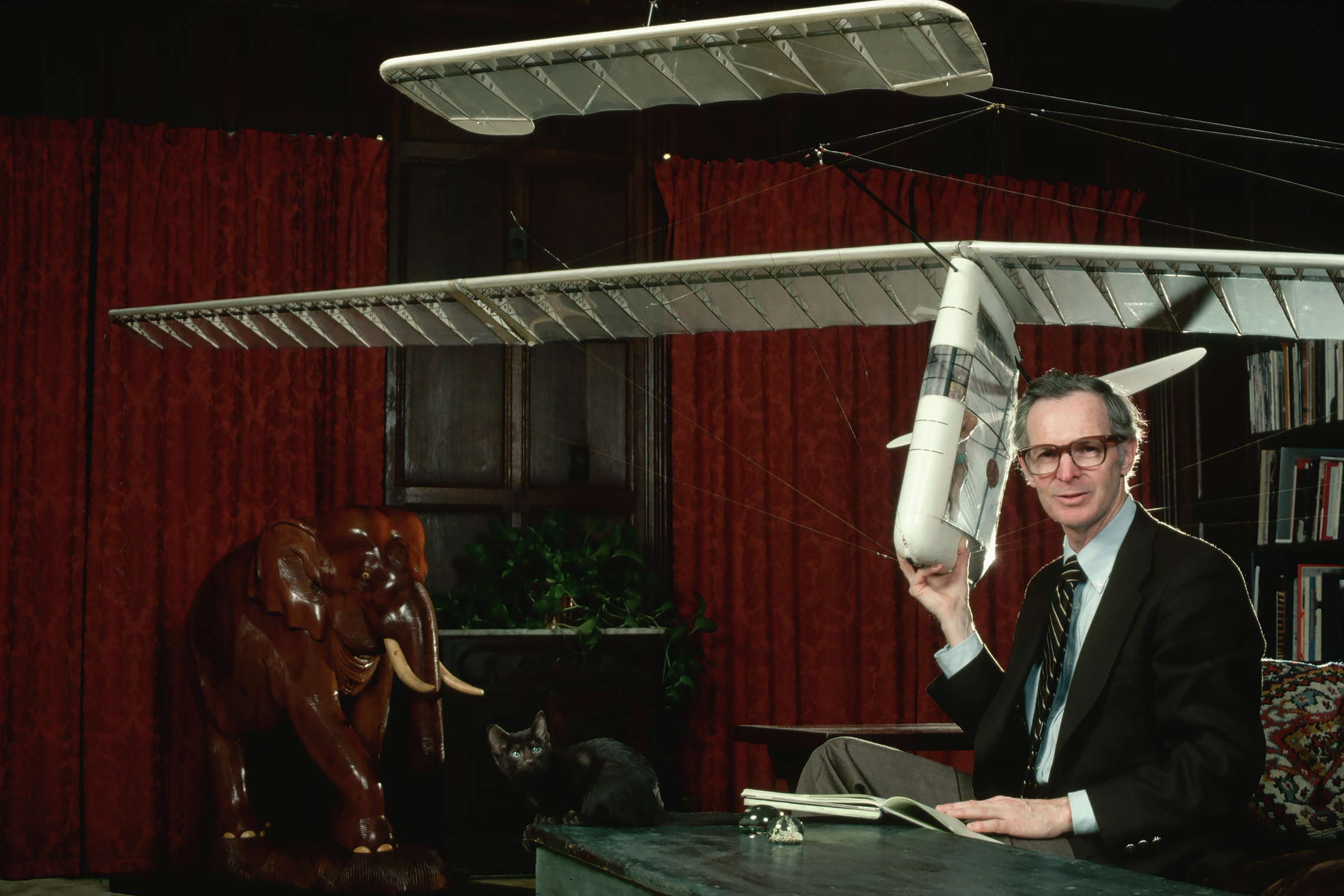
There was one problem that you were able to solve by going back to something that the Wright brothers had learned, wasn’t there?
Paul MacCready: What we really went back to is what birds have been doing for a hundred million years, so who thought of it first is a question. One of the blind alleys that we went up in this development of the Gossamer Condor was — I was picturing that because the flight was so slow and the turns were fairly large, you could just have a wing that always had the same shape and you could gently get around the turn. But when we were having huge problems with the turn and with other aspects of stability and control, I finally sat down and really did some calculations and realized the huge increase of angle of the tack you get in the one wing versus the other wing and that it was necessary — in order to maintain lift —well, a big change of speed, I should say — in order to maintain lift, you have to change the angle of the wing. You just plain have to twist the wing, and when you finally began twisting the wing, it suddenly began working pretty well. But there were a lot of other problems to the stability and control part — but the need to wing twist was important, and I should have figured that out ahead of time and incorporated it right into the very first vehicle. But because I have mental blinders like everybody else, I went off on what I thought was a simpler approach. I tried to do everything on this project as simply as possible, assuming that the simple answer would work. You knew it wouldn’t always, but that saves you a lot of time so when you get to a troublesome thing, you can then spend some time with it.
We figured that one out. Then, by some ingenious tests with a little model that only took an hour to build, pushed around in a swimming pool — just a couple of slabs of balsa wood — we got some final insights about what some computer programs were trying to tell us. The computer programs, a rather elegant technology, were correct, but they didn’t give you any insight. This swimming pool event did give us the insight, and we figured out how to complete all the stability and control problems and came up with a final version that worked.
Can you tell us about the day that it finally worked, when you had your successful flight with the Gossamer Condor?
Paul MacCready: We were getting longer flights each day as we would continue cleaning up, tightening the mylar, getting things so they didn’t ripple as much. Also, getting the pilot more accustomed to it. Finally, he did a flight that almost completed the one-mile figure-eight. You have to do a figure-eight flight around pylons half a mile apart. At the very beginning and at the end, you have to go over a ten-foot marker. You can’t have a ground-effect machine that’s only a millimeter off the ground. He had done a flight of almost eight minutes but had not been able to get up over that last hurdle. So it was obvious that the next time the weather was right, the flight would succeed. Then we got a forecast of appropriate weather and were able to get the official observer out. We all got out there. I don’t remember whether we went out early that morning — very early because it’s a two-and-a-half hour drive from here to get to the airport — or whether we went out the previous night. I suspect it was the previous night. We got everything together, and the flight succeeded on that occasion, just barely.
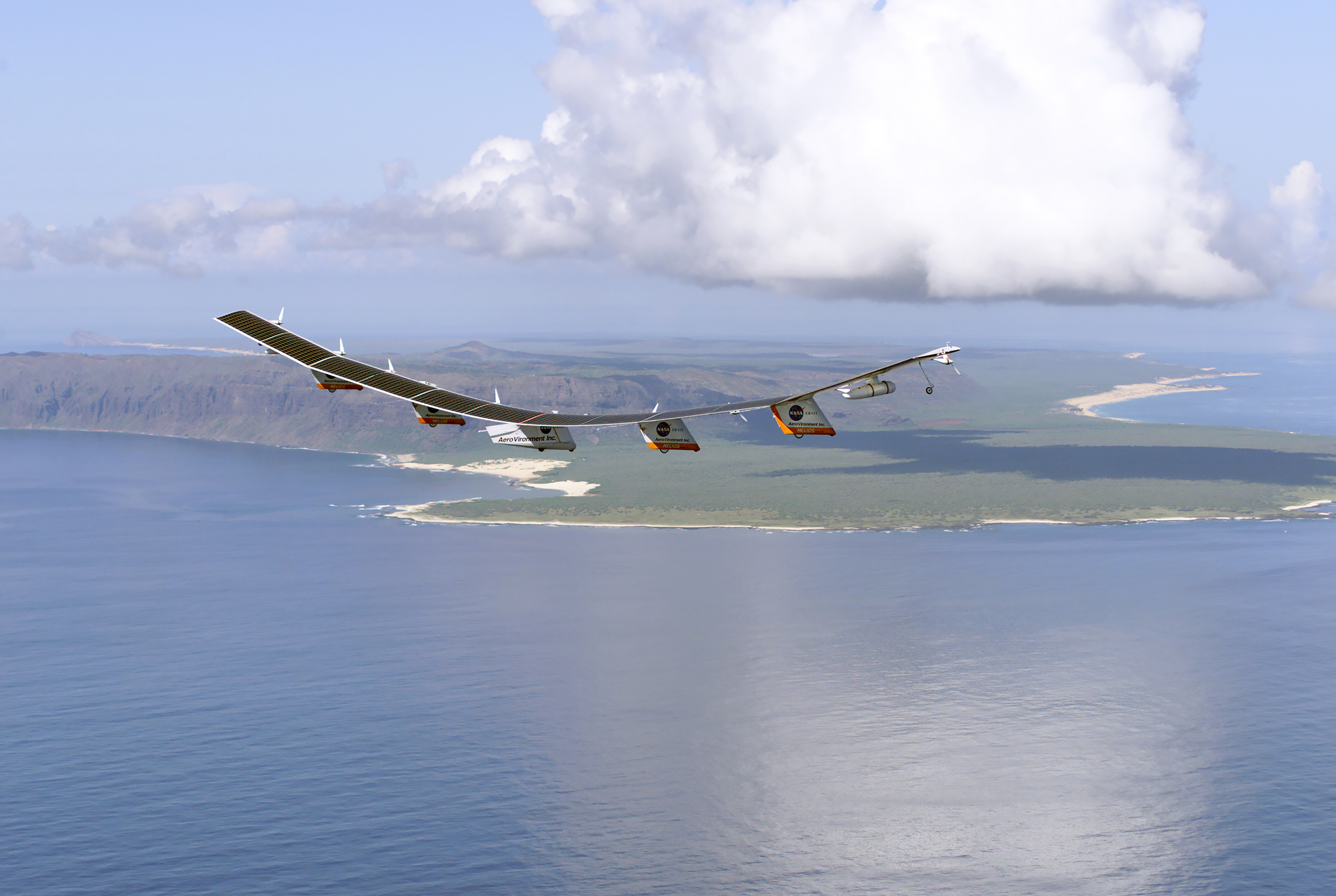
How long was it before you started thinking about the next project?
Paul MacCready: After that prize was won, this prize of Henry Kremer’s that had stood for 18 years no longer existed, and so he didn’t have a prize out. About four months later or so, he put up the new prize for a flight across the English Channel, which is a 22-mile flight across a dangerous body of water. I think he thought it was probably going to take another 18 years for somebody to do that because it was so much longer than this first one-mile flight. We realized that if we just cleaned up the Condor and made a plane that was more elegantly fashioned — a more accurately contoured wing, many more ribs, better foam to help contour the wing, and so on, focused on structure, didn’t pay any new attention to aerodynamics because that had all been solved in the previous one — this new plane, which we would call the Gossamer Albatross, could get by on maybe a third less power. A bicyclist can put out a little less power for a much longer period of time. And so Bryan Allen, our pilot, should be able to fly this new plane for literally hours if we got it properly all cleaned up. So we built it. I guess it was built by mid-spring of the next year.
We were using carbon fiber composite tubes instead of aluminum, and lots of very lightweight foam ribs, and so on — a lot of sort of space-age materials to make a better vehicle. It flew right from the beginning, doing just what it should. But we had all the usual accidents and control problems. It was obvious this was capable of winning the prize, but it was also becoming obvious that this was going to be a big project: to build back-up airplanes, to test them, get them to break in controlled circumstances rather than out over the Channel, get them all to England somehow, wait around for weather, do more tests there, rent boats, and so on. So we sought sponsorship. The DuPont Company, whose materials we were using, agreed to sponsor it. And the project proceeded.
How exciting was the actual flight across the Channel, both for you and for the pilot?
Paul MacCready: Well, the event was perhaps one of the most exciting things certainly that I will ever live through or that any of the people involved with it would live through, but it doesn’t mean it’s something we’d want to go do again. Maybe the pilot was tired, but the 100 other people who were all in boats going along with him, trying to use psychokinesis to lift him up mentally, were certainly exhausted by the time the thing was over. The big pressure was organizing this thing. You had to predict the previous day, by three o’clock, whether you were going to do a flight the next day. And none of the weather forecasts you got ever agreed — or ever agreed with the weather that subsequently materialized. It’s a very difficult area to get good weather forecasts. I’d actually have to ride over on a bike — and a broken foot at the time and a cast on — and I’d have to ride over from the airport to a pay phone and find the weather forecasts and then turn on, or not turn on, the whole project. And once the project was turned on, which it was for this day, about 100 people, journalist types, were converging from all over Europe — and all the team, the DuPont people. It was about like operating D-Day out of a pay telephone booth. It had pressure, and the usual pressures: we were running out of money and the weather wasn’t right. But finally, we thought, “Okay, let’s try it.” There was really zero chance of it working right the first time, and the first plane was considered sort of a sacrificial plane. We didn’t know what was going to go wrong, but we knew some of the 100 things that could go wrong would go wrong. So we assembled the plane on a thing called The Warrens, where one of the early tunnels was starting to be dug from England to France. It’s an acre of concrete just in the right place for us.
So once it got it up in the air over the Channel, then what happened?
Paul MacCready: Well, it was up in the air and everything was going fine. There was radio communication both ways. I was in a boat about 1,500 feet in front of the plane, doing navigating with radar and figuring out where we were, where all the boats in the Channel were, and where they were going to be by the time we reached them. You couldn’t cross in front of one of the big supertankers — in case you crashed, they can’t turn — and you can’t be within two miles behind them because they leave turbulence in the air that would be too much for the plane. So maybe 20 minutes ahead of time, you have to know where you are going to be, where they are going to be, and make little variations in the course. The whole thing was quite a strain.
As to Bryan, we only felt that he could keep the plane up for two hours. Prior tests had shown his stamina at the amount of power the plane required. We only gave him enough water to avoid dehydration for two hours. Any extra water would have added weight, and he couldn’t have lasted the two hours even. Unfortunately, a headwind cropped up that meant that after two hours, he was still nowhere near the French coast. He still had many miles to go. He was all out of water, and the increased wind also made more turbulence in the air, which made the power required a little bit higher for the plane. And finally, he just had to give up and signal for a tow. A little rubber boat with several people in it went around under him and, with a fishing pole, was trying to snag a line onto a little ring on the plane and provide a tow, to tow it to either one coast or the other. But during the maneuver, he had to move up higher, and he found that the air was a lot calmer up there, in the stable air, and the turbulence was damped out, and it took a little less power up high. Usually it takes a little less power down low; there is a ground effect that helps you. But here there was turbulence that was bad down low. When he got up high, it took a little less power, and so he decided that even though they were trying to catch the plane all the time, he kept dodging, and finally he said — the radio wasn’t working then, but he signaled that he didn’t want to be hooked up, and he decided to continue for five more minutes and give it a try, and the five minutes became ten, became 15, became 20.
Some of the time, he was down low. For a while, he was down really just six inches above the water, in the changing winds. Somehow he struggled along as his left leg cramped from the dehydration. He pedaled mostly with his right. Then his right leg would cramp, and he would pedal mostly with his left. Towards the end, both legs were cramped, but he somehow just got that last little bit. And there was extra turbulence that was almost beyond the capability of the plane to handle its controls in just that last bit, 50 meters offshore. But finally, he made it. It was almost a three-hour flight — beyond all odds, just impossible for human stamina to have kept going that long, but he did.
If it had been high tide, I think he wouldn’t have made it because he would have had to go an extra 100 meters to reach the shore. It was that close. He had worked for the last several months before the flight with a full-time exercise physiologist, Professor Joe Mastropaolo, who helped him train to build up his stamina. Bryan was a good bicyclist but hadn’t been doing Olympic training, but he worked at it very hard. Mastropaolo, I think, gave him the real spirit, the attitude, that you just don’t quit. It doesn’t matter how impossible, how painful, if you are conscious, you are still pedaling. And somehow this sunk into Bryan, and what he did then is just so beyond reasonable human stamina, I’ve never seen anything else like it.
So another day of great relief. This pressure was over. We were pretty sure we would succeed sometime, but to have it work the first time was remarkable.
The wheel on the front of the Gossamer Condor, wasn’t it actually from a toy?
Paul MacCready: Those are the lightest. You can’t get any non-toy wheels that are down to the two-ounce, three-ounce category. This was about five inches in diameter. It was only going to be used once on the flight, for a few seconds on takeoff. The rest of the time, it was just dead weight. So you don’t want it good and reliable; you want it just strong enough to handle that. We found that on little toy trucks you could find such wheels, so that’s what we used. The idea of this whole project, and the previous Gossamer Albatross project, the only goal was to win the prize, and it wasn’t to have fun, it wasn’t to make a museum piece, it wasn’t to make something that was ever going to fly a second flight. It was just to win the prize. With the Gossamer Condor, we never even drew plans until after the prize was won. Because you didn’t need plans with the way we were doing it. We used computers for some things, but there were no plans drawn. And it’s rare that you have a project that is so simple — one goal, and you can focus on that. People tend to formalize things more, and they do more drawings, and they make parts better than they need to be. We knew exactly what we were trying to do, and we compromised right to the very limit on every little part. So if a toy wheel worked, great.
